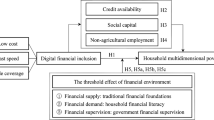Abstract
This research contributes to financial inclusion campaigns initiated by the World Bank as an operational solution for poverty eradication in develo** and emerging economies. The findings of this study can help policy makers to understand the issues related to the prompt expansion of digital financial services, strategies for its effective delivery to the poor and the risks involved in digital financial inclusion. Secondly, this study adds to the existing literatures on emerging digital finance and financial inclusion, which will enable academics and researchers to attend to the effects of digital financial services on financial inclusion.
Access this chapter
Tax calculation will be finalised at checkout
Purchases are for personal use only
Similar content being viewed by others
Notes
- 1.
- 2.
Aadhaar number is a unique 12-digit biometric-based random number issued by the UIDAI (Unique Identification Authority of India) to the residents of India after satisfying the verification process and the enrolment process is totally free of cost. A permanent account number (PAN) is a unique 10-digit alphanumeric number, issued by the Indian Income Tax Department, to any “person” who applies for it or to whom the department allots the number without an application and it is valid across India and is unaffected by a change of name, address within or across states in India or other factors.
- 3.
Sunil Dhawan (2017), ‘This savings account doesn’t require any minimum balance: Find out if it suits you’, article published in Economic Times, India, dated 29 September 2017.
References
Dhawan, S. (2017, September 29). This savings account doesn’t require any minimum balance: Find out if it suits you. Economic Times, India.
Gabor, D., & Brooks, S. (2017). The digital revolution in financial inclusion: International development in the fintech era. New Political Economy, 22(4), 423–436.
Ghosh, S. (2016). Does mobile telephony spur growth? Evidence from Indian states. Telecommunications Policy, 40(10–11), 1020–1031.
Gomber, P., Koch, J. A., & Siering, M. (2017). Digital Finance and FinTech: Current research and future research directions. Journal of Business Economics, 87(5), 537–580.
GPFI (2010). G20 Principles for Innovative Financial Inclusion—Executive Brief. Retrieved from http://www.gpfi.org/publications/g20-principles-innovative-financial-inclusion-executive-brief
Hannig, A., & Jansen, S. (2010). Financial inclusion and financial stability: Current policy issues. ADBI Working Paper No. 259, Asian Development Bank Institute, Tokyo.
Klapper, L., El-Zoghbi, M., & Hess, J. (2016). Achieving the sustainable development goals. The role of financial inclusion. Retrieved May 23, 2016, from http://www.ccgap.org
Manyika, J., Lund, S., Singer, M., White, O., & Berry, C. (2016). Digital finance for all: Powering inclusive growth in emerging economies. Washington, DC: McKinsey Global Institute.
Ozili, P. K. (2018). Impact of digital finance on financial inclusion and stability. Borsa Istanbul Review, 18(4), 329–340.
Peake, C. (2012). New frontiers: Launching digital financial services in rural areas. In The 2012 Brookings Blum Roundtable Policy Briefs. Mercy Corps.
Sarma, M. (2015). Measuring financial inclusion. Economics Bulletin, 35(1), 604–611.
Siddik, M. N. A., Sun, G., & Kabiraj, S. (2015). Financial inclusion and its determinants: A study of Bangladesh. Indian Journal of Finance, 9(6), 7–29.
Author information
Authors and Affiliations
Corresponding author
Editor information
Editors and Affiliations
Rights and permissions
Copyright information
© 2020 The Author(s)
About this chapter
Cite this chapter
Siddik, M.N.A., Kabiraj, S. (2020). Digital Finance for Financial Inclusion and Inclusive Growth. In: George, B., Paul, J. (eds) Digital Transformation in Business and Society. Palgrave Macmillan, Cham. https://doi.org/10.1007/978-3-030-08277-2_10
Download citation
DOI: https://doi.org/10.1007/978-3-030-08277-2_10
Published:
Publisher Name: Palgrave Macmillan, Cham
Print ISBN: 978-3-030-08276-5
Online ISBN: 978-3-030-08277-2
eBook Packages: Business and ManagementBusiness and Management (R0)



